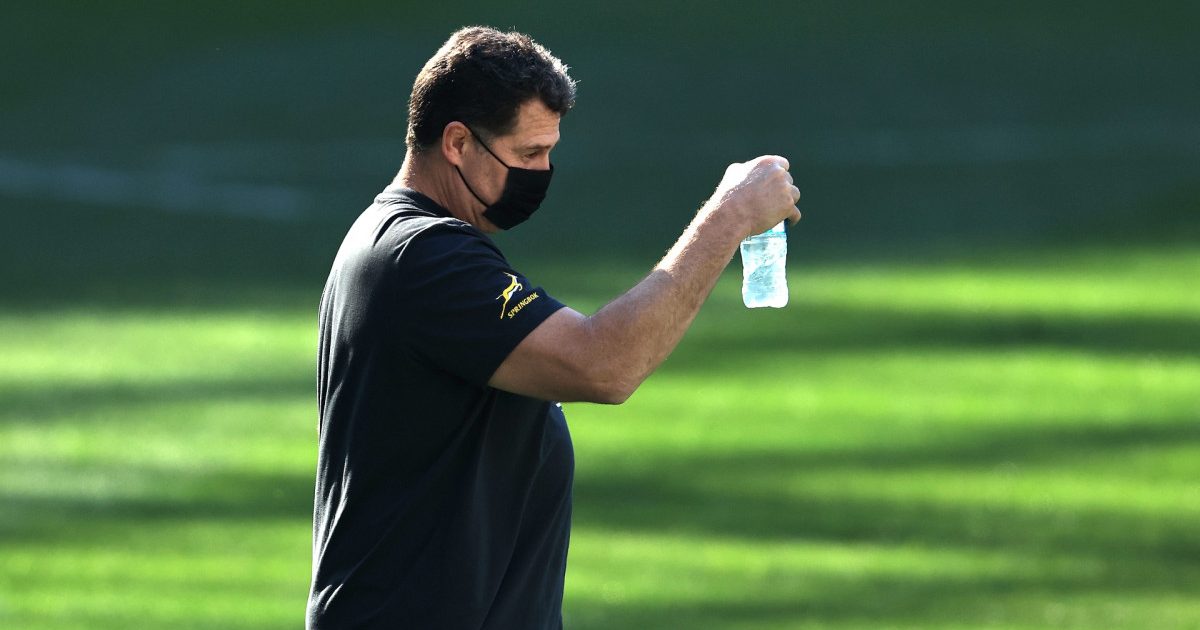What rugby must do to keep mischief-making water carriers in check

Take a break, have a KitKat. A familiar advertising campaign from several years back, but also a catchphrase with which supporters of one Greene King IPA Championship side have become very familiar…
The role of the rugby water carriers has come to wider public awareness since Springboks boss Rassie Erasmus donned a fluorescent bib and headset during the summer series against the Lions. He also carried water bottles when he remembered.
Last weekend the subject of on-field H2O again reared its head as referee Wayne Barnes was twice required to send off Wasps coaches disguised as water carriers for what their subsequent disciplinary hearing described as “conduct prejudicial to the interests of the union and the game”.
The Coventry club’s head of performance, Pete Atkinson, was despatched to the sidelines immediately following Exeter’s second try – a great finish by Facundo Cordero – for comments made to the referee.
And he was joined in the technical area in the second half by backs and transition coach Scott Barrow, who triggered a pitch-side fracas with his sly attempt to slow down play and prevent Exeter players from recovering the ball behind the home side’s posts.
Both have since been banned from attending their club’s visit to Saracens on Sunday in a working capacity and – amusingly – been given a naughty-schoolboy-style punishment which requires them to present the contents of Premiership Rugby’s rules for technical area staff to the rest of Wasps’ off-field staff.
DISCIPLINARY: Verdict issued following online hearing regarding two incidents that happened last Saturday at Wasps#Wasps #WASvEXE #GallagherPrem
https://t.co/3XDSHy2ZJT— RugbyPass (@RugbyPass) October 20, 2021
English rugby regulations allow two water carriers and three medics per team to operate within the playing enclosure – the area inside the advertising boards. The team manager is the only other person permitted in the technical area with the independent doctor, replacements, fourth official and reserve referee.
But, as is invariably the case in professional sport, the clubs have used technology to push the envelope way beyond what was ever envisaged in an attempt to achieve small gains.
Having experienced this situation closely at first hand, there are various aspects to the problems being caused.
This whole issue stems from the director of rugby or head coach almost never being content to allow his players to make game-management decisions and therefore needing a way to communicate with them while play is going on.
Think it’s the captain or fly-half who opts to kick to the corner instead of taking three points? Think again.
As rugby’s authorities began to understand the physiological dangers of dehydration the idea of regular water breaks, which coincide with injury stoppages or when play stops for a conversion, seemed to make sense – doubly so in warmer climes.
But while the men in suits probably envisaged a couple of ball boys trotting on with a few bottles, the clubs quickly spotted an opportunity to get coaching staff closer to the action. While the medics are all qualified physiotherapists they are also capable, albeit sometimes reluctantly, of passing on a tactical message.
Two of them are also allowed to track play along the sidelines, which brings us to the subject of chocolate bars! Bluetooth headsets allow the boss in the stand to have an open line to all five personnel who are allowed pitch-side, plus the dug-out.
“KitKat” is the coded instruction used by one Championship club’s DOR when the game needs slowing down or stopping for tactical reasons. When any of the pitch-side staff hear this through their headset they instantly yell it at their front row and one of them feigns injury.
Since the game cannot continue beyond the next set-piece without six fit front row forwards, the majority of the time the referee stops play regardless of how suspicious he/she may be.
The problem that Premiership Rugby faces here is that preventing dehydration and having medics very close to the action are both essential tools in dealing with injury prevention and wider player well-being. But despite this, it is surely time to apply some common sense and stop this give-them-an-inch-and-they-take-a-mile scenario.
In the British climate, do players really need access to limitless water? Instead, how about one scheduled water break in the middle of each half which the referee times to coincide with a break in play. There would then be no issue with coaches going on the field during what could be a strictly timed 90-second interlude.
Further, while the medical staff clearly need an open line in case of emergency, why do the coaches or management of either team need the ability to access this? I would legislate to prevent this happening and heavily punish any club found by the fourth official or reserve referee to be using medical staff for tactical purposes.
While this all seems draconian, if nothing is done it is only a matter of time before we have rugby water carriers fighting with players, each other or sparking a major incident on the touchline.
It would also require senior players to go back to the days when they had decision-making responsibility.
And as an added benefit, a KitKat would go back to being a chocolate bar…
What is it with waterboys at the moment? ??
Credit: @btsportrugby | #WASvEXEpic.twitter.com/EfYooZuX0X
— RugbyPass (@RugbyPass) October 16, 2021










































